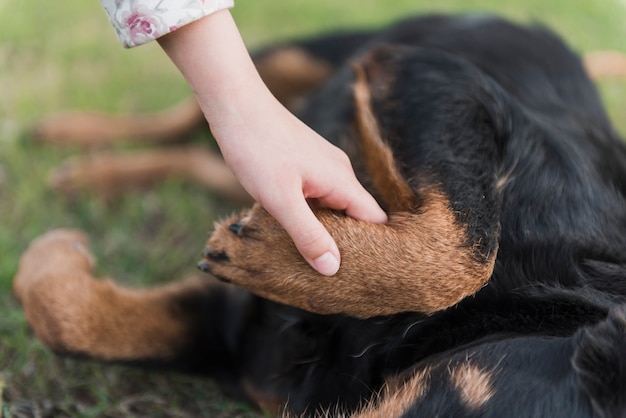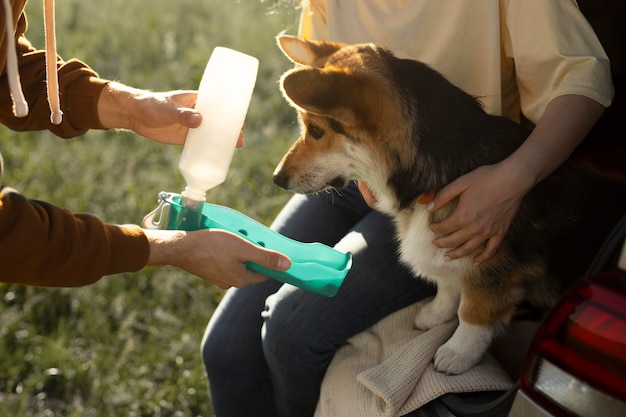When Is Your Pet’s Limp an Emergency Problem?


When Is Your Pet’s Limp an Emergency Problem?
If you’ve ever noticed your dog or cat suddenly limping, you know how alarming it can feel. One moment your pet is moving happily across the living room, and the next, they’re holding up a paw or hobbling with each step. As a pet parent, it’s natural to wonder if a limp means your companion needs help right away or if it can wait until your regular veterinary clinic is open. At South Texas Veterinary Urgent Care, located at 4133 Gollihar Road, Corpus Christi, TX 78411, we understand how stressful these situations can be for Corpus Christi and surrounding communities. We specialize in providing urgent care for pets, including sudden lameness or limping, so you never have to wait for answers when your pet’s comfort is on the line.
This blog will help you recognize the signs that require emergency limping in pets, explain the most common causes, and guide you step by step on what you should do next. You’ll also discover when to seek cat or dog limping urgent care and how to find an emergency vet near me, especially when your regular veterinarian isn’t available. Walk-ins are always welcome at our clinic, so you can rest easy knowing immediate care is available whenever your pet needs it. If you’re looking for more in-depth information about pet limping, visit our detailed lameness care page as well.
Recognizing Emergency Limping in Pets: How to Spot the Signs
Every pet will likely experience a sore paw or minor limp at some point. Determining what qualifies as an emergency limping in pets can feel overwhelming, especially if your pet is stoic or tries to hide pain. While some limps are mild and resolve quickly, others signal an urgent medical issue needing prompt attention.
Key symptoms of emergency lameness include an inability to bear any weight on a limb, sudden yelping or vocalizing when trying to walk, or visible deformity such as a limb pointing in the wrong direction. Swelling, bleeding, or severe bruising around a leg or paw are also warning signs. In some cases, your pet may refuse to move, drag a limb behind them, or become unusually withdrawn or aggressive due to pain. Other indications that should never be ignored are open wounds, especially if bone or tissue is exposed, or signs of shock such as pale gums, rapid breathing, or collapse.
For example, if your dog sprints after a ball and then returns holding one paw up, whimpering and unable to put any weight on it, this is a clear sign that urgent veterinary care is needed. Similarly, if you notice your cat is hiding and hissing when you approach, accompanied by a limp and swelling in the leg, immediate attention at an urgent care clinic is vital.
If you ever feel uncertain about the severity of your pet’s limp, it is always safer to have them evaluated by a veterinary professional. Our urgent care services in Corpus Christi are designed to provide quick access to care for exactly these kinds of situations.
Understanding Why Pets Limp: Common Causes of Sudden Lameness
A limp in dogs or cats can develop for many reasons, ranging from mild injuries to life-threatening emergencies. The most common causes of cat or dog limping urgent care visits include trauma, such as falls, being hit by a car, or getting a limb caught in furniture. Soft tissue injuries like sprains, strains, or torn ligaments can also cause sudden limping and are often accompanied by swelling or bruising.
Bone fractures or dislocations require immediate veterinary attention, especially if you notice a limb at an odd angle or hear a cracking sound during the injury. Wounds or lacerations to the paw pads may occur after stepping on glass, thorns, or sharp objects during walks in Corpus Christi, particularly after storms or in areas with debris. Sometimes, abscesses from bites or scratches can cause significant pain and swelling, especially in outdoor cats or dogs that play rough with others.
Other causes include insect or snake bites, which are a notable concern in South Texas, as well as foreign bodies like thorns, cactus spines, or foxtails embedded in the skin or between the toes. Joint conditions such as arthritis are generally less urgent but can flare up dramatically, especially in older pets or after heavy activity.
In rare but serious cases, sudden limping may indicate a neurological issue, spinal injury, or even a blood-clotting disorder that needs urgent evaluation. If your pet’s limp appears out of nowhere and is accompanied by other symptoms such as bleeding, difficulty breathing, or collapse, seeking emergency veterinary care in Corpus Christi becomes critical.
Professional Treatment Options for Emergency Limping in Pets
When your pet arrives at South Texas Veterinary Urgent Care, our veterinary team will begin with a thorough physical exam, assessing your pet’s gait, range of motion, and pain response. Diagnostic imaging, such as digital radiology or ultrasound, may be recommended to identify fractures, dislocations, or internal injuries. Our lameness care services are tailored to quickly diagnose and address the underlying cause, ensuring the most effective treatment for your pet.
Treatment approaches vary depending on the diagnosis. For mild sprains or strains, rest, anti-inflammatory medication, and controlled leash walks are often prescribed. Severe injuries, such as broken bones, may require splinting, casting, or surgical intervention. South Texas Veterinary Urgent Care is equipped to perform internal surgery, manage complex wounds, and address urgent orthopedic issues. Open wounds or lacerations are cleaned and sutured, and pain management is always a top priority.
If your pet’s limp is caused by an abscess or infection, we may drain the area and administer antibiotics to control the spread of bacteria. In cases of foreign objects in the paw, our team carefully removes the offending item and treats any resulting wounds. For snake bites or venomous stings, immediate supportive care is provided, which may include antivenom, pain relief, and intensive monitoring.
Our clinic in Corpus Christi is prepared for all urgent scenarios, so you never have to wait for your regular veterinarian when your pet is suffering. If your pet’s lameness is severe or worsening, don’t hesitate to seek emergency veterinary care right away.
Home Care and Prevention: What Pet Owners Can Do
While some limps can be managed at home with rest and observation, it is crucial to know when home care is appropriate and when it’s not. If your pet’s limp is mild, not worsening, and there are no other concerning symptoms, you can try restricting their activity, preventing jumping or running, and monitoring closely for any change. Keeping your pet’s nails trimmed, avoiding rough play, and being mindful of hazards like sharp objects or uneven surfaces around your home can help minimize the risk of injury.
During walks in Corpus Christi, especially after heavy rain or wind, check your pet’s paws for thorns, debris, or cuts. Regular grooming and inspection of the paws and legs allow you to detect early signs of injury or infection before they become emergencies. If your pet is older or has a history of joint issues, provide soft bedding, ramps, or steps to reduce strain on their limbs. Use caution during extreme temperature fluctuations, as hot pavement or icy conditions can increase the risk of slips and falls.
However, if your pet’s limp is accompanied by swelling, bleeding, visible wounds, or they refuse to put any weight on the limb, do not attempt to treat it at home. Delaying care can worsen the injury and reduce your pet’s long-term mobility. If you are ever in doubt, our urgent care vet near me in Corpus Christi is available for immediate evaluation—no appointment needed.
When to Seek Emergency Veterinary Care for Limping
Knowing when to seek emergency limping in pets is essential for every pet owner. Immediate veterinary care is needed when your pet cannot walk or stand, is in severe pain, or shows signs of trauma like bleeding, swelling, or deformity. Additional red flags include open wounds, exposed bone, bites from other animals, or the presence of foreign objects in the paw or limb. If your pet collapses, is unresponsive, or develops sudden lameness along with vomiting, pale gums, or difficulty breathing, these are signs of a medical emergency.
It is also important to seek urgent care if your pet’s limp is not improving after a few hours of rest, worsens rapidly, or is accompanied by fever, lethargy, or changes in appetite. In some cases, conditions like abscesses can develop under the skin, causing pain and swelling that require prompt drainage and antibiotics. Our abscess treatment services are designed for these situations.
For pet owners in Corpus Christi and surrounding communities, our team of urgent care veterinarians is available during off-hours, evenings, and weekends. Walk-ins are always welcome; you do not need an appointment to access our emergency veterinary care. Remember, waiting for your regular veterinarian when your pet is in pain can lead to complications and prolonged suffering.
Take Action for Your Pet: Walk-Ins Always Welcome at South Texas Veterinary Urgent Care
A sudden limp in your dog or cat can be frightening, but you do not have to face it alone or wait for normal business hours. South Texas Veterinary Urgent Care at 4133 Gollihar Road, Corpus Christi, TX 78411 is dedicated to providing immediate, compassionate care for emergency limping in pets, cat or dog limping urgent care, and a wide range of urgent medical needs. Our clinic serves Corpus Christi and surrounding communities, ensuring your companion receives expert help exactly when needed.
If you are searching for an emergency vet near me or an urgent care vet near me, remember that our doors are open for walk-ins with no appointment required. Our veterinary professionals are ready to help your pet recover, offering advanced diagnostics, wound care, and pain management tailored to your pet’s needs. When your pet’s comfort and mobility are at stake, do not hesitate—visit us for emergency veterinary care or call (361) 833-6022 for guidance. Your pet’s health and happiness are our top priorities, and we are here to support you through every urgent moment.
For more information on our lameness and urgent care services, visit our lameness care page or stop by our clinic today. Your pet’s wellbeing is worth immediate attention—let us help you protect it.
References:
American College of Veterinary Surgeons: Lameness in Dogs and Cats (Link)
American Veterinary Medical Association: Signs of Pain in Pets (Link)
Cornell University College of Veterinary Medicine: Limping in Dogs (Link)
This article is for informational purposes only and should not replace professional veterinary care. If your pet is limping or showing signs of pain, contact a veterinary professional immediately for a proper diagnosis and treatment plan.




















